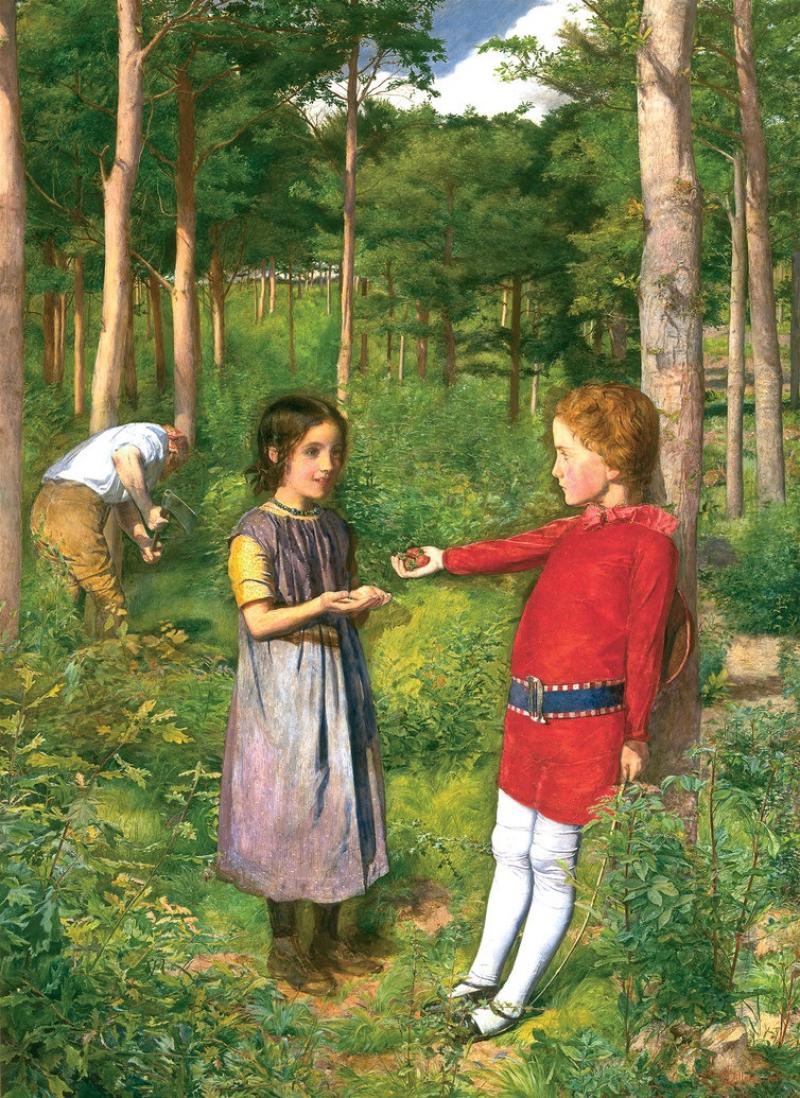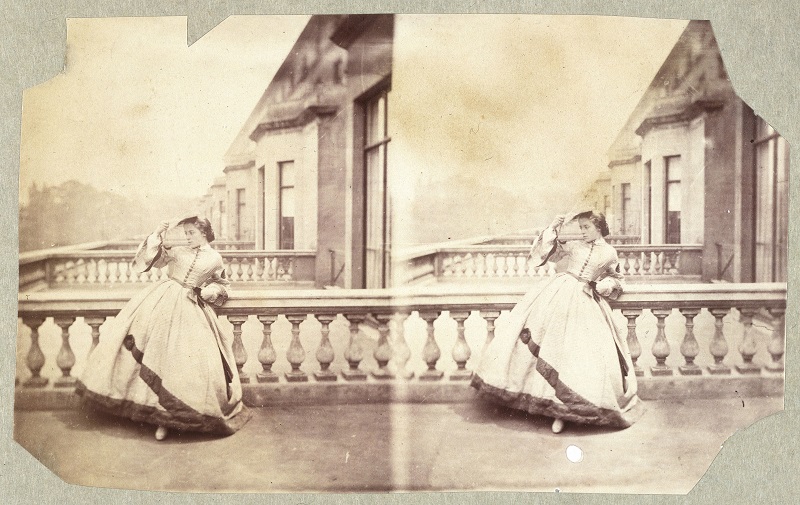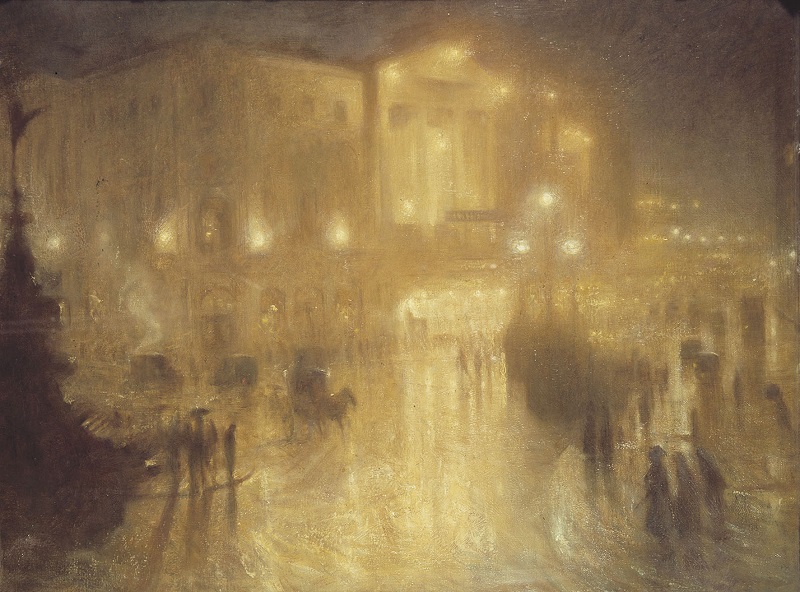Painting with Light, Tate Britain | reviews, news & interviews
Painting with Light, Tate Britain
Painting with Light, Tate Britain
How early photography revolutionised the way that painters saw the world

Today we amuse ourselves with Facebook clips of talking cats, but in the 1850s they had stereographs, pairs of identical photographs that, viewed through special lenses, become suddenly and gloriously three-dimensional. Vistas open up as if by magic, the illusion of space all the more beguiling for its transience.
Looking at a stereograph of a woodland scene, each leaf so crisply defined it might have been cut out and pressed into place, it seems truly remarkable that it was only 11 years earlier that the first photographic images were made. Ghostly and intensely atmospheric, those photographs made up for in ethereal beauty what they lacked in definition and clarity, but by the 1850s all this had changed: photography was a medium capable of recording the world in minute detail.
 Indeed it is this stereograph’s remarkable sharpness that strikes you, but seen next to a contemporaneous painting, The Woodman’s Daughter, 1850-51, by John Everett Millais (main picture), the ramifications of stereoscopic photography, easily dismissed as idle entertainment, seem much more profound (pictured above right: an example of a stereoscopic photograph by Clementina Hawarden, Isabella Grace on the Terrace, c.1861-2). You can see that Millais had been looking at photographs, the almost forensic details of the painting reminiscent of the clarity afforded by photography. The scene is dominated by woodland and allows only the smallest patch of sky, a compositional technique used by photographers to avoid the exposure problems that can result from vastly differing light sources. Inspired by photography, the painting represents a genuine attempt to see differently.
Indeed it is this stereograph’s remarkable sharpness that strikes you, but seen next to a contemporaneous painting, The Woodman’s Daughter, 1850-51, by John Everett Millais (main picture), the ramifications of stereoscopic photography, easily dismissed as idle entertainment, seem much more profound (pictured above right: an example of a stereoscopic photograph by Clementina Hawarden, Isabella Grace on the Terrace, c.1861-2). You can see that Millais had been looking at photographs, the almost forensic details of the painting reminiscent of the clarity afforded by photography. The scene is dominated by woodland and allows only the smallest patch of sky, a compositional technique used by photographers to avoid the exposure problems that can result from vastly differing light sources. Inspired by photography, the painting represents a genuine attempt to see differently.
Most obviously, photography presented painters with a useful new tool, providing a means of recording compositions and details for later reference, but here this represents just one aspect of the subtle but total infiltration of visual culture by photography. Part of the story is the painstaking work done by pioneers Robert Adamson and David Octavius Hill, whose panoramic photographs provided direct source material for Hill’s epic paintings of Edinburgh, but no less important is John Ruskin’s watercolour of The North-West Angle of the Facade of St Mark’s, Venice (undated), its close-cropped viewpoint informed specifically by photography.
The extent to which photography changed the way people, especially artists, viewed the world can only really be fully appreciated if we understand just how important paintings and printed images were at this time and the sheer excitement they could inspire. While we are used to the odd flurry of outrage provoked, usually, by the Turner Prize, a less cynical public response is far rarer.
 Tate Britain's dreary exhibition about history painting last year completely failed to address the bodice-ripping appeal of paintings like Charles Landseer’s The Plundering of Basing House, 1836. In contrast, the nature of the Victorian public's engagement with the painting is effortlessly conveyed here, through a series of stereographs that develop the narrative of Landseer's painting into three further scenes. They show the extent to which these sorts of history paintings could be experienced as moments of high drama, at an emotional pitch so intense that a whole narrative sequence could take flight in the viewer’s imagination, heightened by the three-dimensional effects of the stereoscope.
Tate Britain's dreary exhibition about history painting last year completely failed to address the bodice-ripping appeal of paintings like Charles Landseer’s The Plundering of Basing House, 1836. In contrast, the nature of the Victorian public's engagement with the painting is effortlessly conveyed here, through a series of stereographs that develop the narrative of Landseer's painting into three further scenes. They show the extent to which these sorts of history paintings could be experienced as moments of high drama, at an emotional pitch so intense that a whole narrative sequence could take flight in the viewer’s imagination, heightened by the three-dimensional effects of the stereoscope.
A similarly sensationalist impulse fuelled the popularity of Henry Wallis's 1856 portrayal of the death of Thomas Chatterton, the 18th-century poet who committed suicide aged 17. The painting toured the British Isles and attracted huge crowds, and so inevitably a stereoscopic image of the painting was issued, intended to be the first in a series illustrating Chatterton's life. Such spin-offs must have been incredibly profitable: the printmaker licensed to publish engravings of Wallis's painting went to court to have the stereoscope series stopped.
At a time when images of all sorts were more available than they had ever been, to people of all social classes, the invention of photography not only aided the reproduction and transmission of images, but added further to a rich and thriving visual culture. Instead of seeing the early years of photography as a period of immaturity, it is presented here as a medium bursting with confidence and faith in its own potential. The pictorialist impulses often interpreted as the insecurities of a new medium desperately trying to prove its worth are presented here as one side of a highly productive dialogue. Painters are shown reassessing the way they looked at the world, thinking differently about composition and the fall of light, in a direct response to photography (pictured above left: Arthur Hacker, A Wet Night at Piccadilly Circus, 1910). In turn, painters like Whistler inspired photographers to experiment with the expressive qualities of their medium.
- Painting with Light: Art and Photography from the Pre-Raphaelites to the Modern Age at Tate Britain until 25 September
rating
Share this article
The future of Arts Journalism
You can stop theartsdesk.com closing!
We urgently need financing to survive. Our fundraising drive has thus far raised £49,000 but we need to reach £100,000 or we will be forced to close. Please contribute here: https://gofund.me/c3f6033d
And if you can forward this information to anyone who might assist, we’d be grateful.

Subscribe to theartsdesk.com
Thank you for continuing to read our work on theartsdesk.com. For unlimited access to every article in its entirety, including our archive of more than 15,000 pieces, we're asking for £5 per month or £40 per year. We feel it's a very good deal, and hope you do too.
To take a subscription now simply click here.
And if you're looking for that extra gift for a friend or family member, why not treat them to a theartsdesk.com gift subscription?
more Visual arts
 'We are bowled over!' Thank you for your messages of love and support
Much-appreciated words of commendation from readers and the cultural community
'We are bowled over!' Thank you for your messages of love and support
Much-appreciated words of commendation from readers and the cultural community
 Photo Oxford 2025 review - photography all over the town
At last, a UK festival that takes photography seriously
Photo Oxford 2025 review - photography all over the town
At last, a UK festival that takes photography seriously
![SEX MONEY RACE RELIGION [2016] by Gilbert and George. Installation shot of Gilbert & George 21ST CENTURY PICTURES Hayward Gallery](https://theartsdesk.com/sites/default/files/styles/thumbnail/public/mastimages/Gilbert%20%26%20George_%2021ST%20CENTURY%20PICTURES.%20SEX%20MONEY%20RACE%20RELIGION%20%5B2016%5D.%20Photo_%20Mark%20Blower.%20Courtesy%20of%20the%20Gilbert%20%26%20George%20and%20the%20Hayward%20Gallery._0.jpg?itok=7tVsLyR-) Gilbert & George, 21st Century Pictures, Hayward Gallery review - brash, bright and not so beautiful
The couple's coloured photomontages shout louder than ever, causing sensory overload
Gilbert & George, 21st Century Pictures, Hayward Gallery review - brash, bright and not so beautiful
The couple's coloured photomontages shout louder than ever, causing sensory overload
 Lee Miller, Tate Britain review - an extraordinary career that remains an enigma
Fashion photographer, artist or war reporter; will the real Lee Miller please step forward?
Lee Miller, Tate Britain review - an extraordinary career that remains an enigma
Fashion photographer, artist or war reporter; will the real Lee Miller please step forward?
 Kerry James Marshall: The Histories, Royal Academy review - a triumphant celebration of blackness
Room after room of glorious paintings
Kerry James Marshall: The Histories, Royal Academy review - a triumphant celebration of blackness
Room after room of glorious paintings
 Folkestone Triennial 2025 - landscape, seascape, art lovers' escape
Locally rooted festival brings home many but not all global concerns
Folkestone Triennial 2025 - landscape, seascape, art lovers' escape
Locally rooted festival brings home many but not all global concerns
 Sir Brian Clarke (1953-2025) - a personal tribute
Remembering an artist with a gift for the transcendent
Sir Brian Clarke (1953-2025) - a personal tribute
Remembering an artist with a gift for the transcendent
 Emily Kam Kngwarray, Tate Modern review - glimpses of another world
Pictures that are an affirmation of belonging
Emily Kam Kngwarray, Tate Modern review - glimpses of another world
Pictures that are an affirmation of belonging
 Kiefer / Van Gogh, Royal Academy review - a pairing of opposites
Small scale intensity meets large scale melodrama
Kiefer / Van Gogh, Royal Academy review - a pairing of opposites
Small scale intensity meets large scale melodrama
 Jenny Saville: The Anatomy of Painting, National Portrait Gallery review - a protégé losing her way
A brilliant painter in search of a worthwhile subject
Jenny Saville: The Anatomy of Painting, National Portrait Gallery review - a protégé losing her way
A brilliant painter in search of a worthwhile subject
 Abstract Erotic, Courtauld Gallery review - sculpture that is sensuous, funny and subversive
Testing the boundaries of good taste, and winning
Abstract Erotic, Courtauld Gallery review - sculpture that is sensuous, funny and subversive
Testing the boundaries of good taste, and winning
 Edward Burra, Tate Britain review - watercolour made mainstream
Social satire with a nasty bite
Edward Burra, Tate Britain review - watercolour made mainstream
Social satire with a nasty bite

Add comment